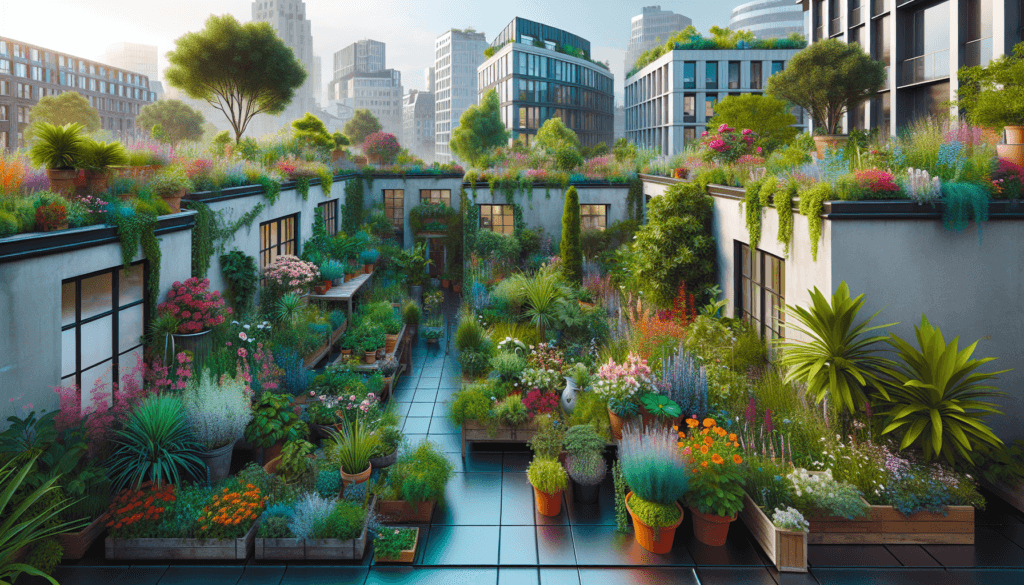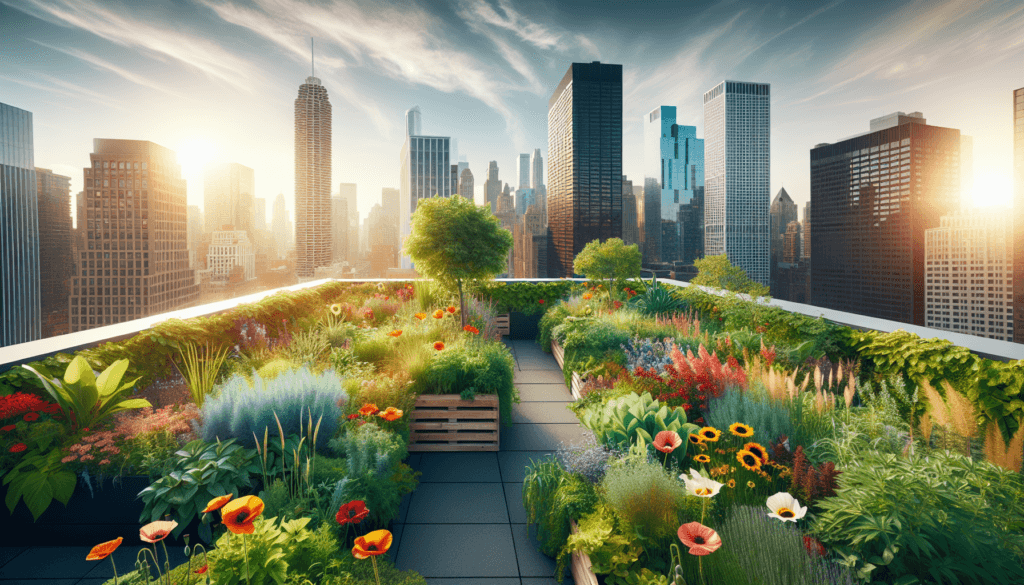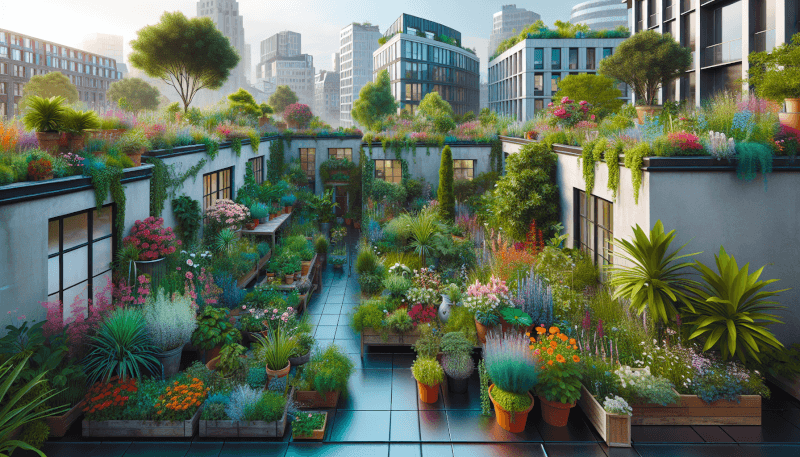Imagine stepping into a lush oasis nestled high above the city, where the air is infused with the scent of blooming flowers and the sounds of birdsong fill your ears. Welcome to the High Garden Rooftop, a hidden gem that offers a sanctuary from the hustle and bustle below. With its breathtaking panoramic views and vibrant greenery, this rooftop haven is the perfect escape for those seeking tranquility amidst the urban landscape. Whether you’re looking to unwind with a refreshing drink, indulge in delectable cuisine, or simply bask in the serene atmosphere, High Garden Rooftop promises an unforgettable experience that will leave you feeling rejuvenated and inspired.

Design and Architecture
Sustainable materials and green infrastructure
When designing a high garden rooftop, it is important to consider sustainable materials and green infrastructure. By using eco-friendly materials like recycled plastics, sustainable wood, and low VOC paints, you can reduce the environmental impact of your rooftop garden. Incorporating green infrastructure elements, such as rain gardens and green walls, can also help manage stormwater runoff and provide habitats for beneficial wildlife.
Integration of natural elements
To create a harmonious and visually appealing high garden rooftop, it is crucial to integrate natural elements. This can be achieved through the strategic placement of plants, trees, and water features. Consider incorporating a variety of textures, colors, and heights to create an immersive and natural experience. You can also add natural materials like stone or wood to enhance the overall aesthetic and create a seamless connection with nature.
Maximizing space utilization
One of the key challenges when designing a high garden rooftop is maximizing the limited space available. To make the most of your rooftop area, consider using vertical gardening techniques such as trellises or hanging planters. Utilize multifunctional furniture that can double as storage or seating to optimize the space. Think creatively and strategically to ensure every inch of your rooftop is utilized effectively and efficiently.
Landscaping and Gardening
Selection of plants and trees
When selecting plants and trees for your high garden rooftop, it is essential to choose species that are suitable for rooftop conditions. Consider factors such as sunlight exposure, wind levels, and the weight-bearing capacity of the roof. Opt for drought-resistant plants to minimize water usage and choose trees with shallow root systems that won’t compromise the structural integrity of the rooftop.
Creating an urban oasis
Transforming your rooftop into an urban oasis involves careful planning and design. Incorporate a variety of plants, flowers, and shrubs to create a lush and vibrant atmosphere. Introduce elements such as pergolas, arbors, and water features to enhance the overall ambiance. By creating a serene and tranquil space amidst the hustle and bustle of the city, you can escape into your own private oasis.
Maintenance and care
Maintaining a high garden rooftop requires regular care and attention. Regular watering, fertilization, and pruning are necessary to ensure the health and vitality of your plants. Consider using organic fertilizers and pest control methods to minimize the impact on the environment. Regularly inspect your rooftop garden for pests, diseases, and weed growth to address any issues promptly.
Benefits of High Garden Rooftops
Environmental advantages
High garden rooftops offer numerous environmental advantages. They help mitigate the urban heat island effect, reduce stormwater runoff, and provide insulation, thus reducing energy consumption. Rooftop gardens also act as carbon sinks, improving air quality by absorbing pollutants and producing oxygen. By incorporating native plants, you can support local biodiversity and provide habitats for birds, butterflies, and other wildlife.
Increased property value
A well-designed and maintained high garden rooftop can significantly increase the value of your property. Rooftop gardens are seen as desirable and luxurious features that enhance the overall appeal of a property. They create unique and memorable outdoor spaces that can be enjoyed by residents and prospective buyers alike. A high garden rooftop can set your property apart from others and potentially attract a higher resale value.
Improved air quality
One of the most notable benefits of high garden rooftops is the improved air quality they provide. Plants naturally filter and purify the air by capturing and absorbing pollutants. By creating a green oasis on your rooftop, you can contribute to reducing air pollution, creating a healthier and more rejuvenating environment for yourself and the surrounding community.

Creating a High Garden Rooftop
Structural considerations
Before creating a high garden rooftop, it is necessary to assess the structural capacity of your roof. Consult with a structural engineer to ensure that the roof can support the additional weight of the garden, planters, and any necessary features. Reinforcements or modifications may be required to ensure the safety and stability of the structure.
Waterproofing
To prevent water damage to your building, proper waterproofing is crucial for a high garden rooftop. Install a high-quality waterproofing membrane that protects the underlying roofing material from moisture penetration. Ensure that all edges, seams, and penetrations are properly sealed to prevent leaks and water damage.
Irrigation system installation
Maintaining the health and vitality of your rooftop garden requires an efficient irrigation system. Consult with a professional landscaper or irrigation specialist to design and install a system that meets the specific needs of your plants and rooftop environment. Consider options such as drip irrigation, which delivers water directly to the roots of the plants, minimizing water waste and ensuring optimal hydration.
Types of High Garden Rooftops
Container gardens
Container gardens are a popular choice for high garden rooftops due to their versatility and ease of maintenance. They involve planting various plants in containers or pots, allowing for flexibility in arrangement and mobility. Container gardens are ideal for rooftop gardens with limited space or weight-bearing capacity.
Green roofs
Green roofs, also known as living roofs, involve covering the entire rooftop with a layer of vegetation. This type of high garden rooftop provides numerous environmental benefits, including insulation, stormwater management, and improved air quality. Green roofs often require specialized structural support and professional installation.
Roof gardens
Roof gardens are similar to green roofs but typically involve the creation of specific areas for gardening and recreational purposes. They can include planters, seating areas, and pathways, creating a more interactive and enjoyable rooftop garden experience. Roof gardens are highly customizable and can be designed to suit individual preferences and needs.
Choosing the Right Plants
Climate suitability
When choosing plants for your high garden rooftop, consider the climate in your region. Select plants that are well-suited to the local climate conditions, including temperature, sunlight levels, and precipitation. Native plants are often a great choice as they have adapted to the local climate and require less maintenance.
Plant selection criteria
Consider factors such as the size, growth rate, and maintenance requirements of the plants when making your selection. Choose plants that will thrive in the specific rooftop environment, taking into account factors such as wind exposure, sunlight levels, and soil conditions. Opt for a variety of plants to create visual interest and ensure year-round appeal.
Consideration of maintenance
Consider the level of maintenance required for each plant species when designing your high garden rooftop. Some plants may require more frequent watering, fertilization, or pruning, while others may be more low-maintenance. It is essential to choose plants that align with your time commitment and gardening abilities to ensure a successful and sustainable rooftop garden.
Designing for Functionality
Seating and relaxation areas
Designing a high garden rooftop involves considering the functionality of the space. Incorporate seating and relaxation areas, such as comfortable loungers, hammocks, or benches, to create inviting spots for rest and relaxation. Choose durable outdoor furniture that can withstand exposure to the elements and provide a comfortable and enjoyable experience for you and your guests.
Outdoor dining spaces
Creating an outdoor dining space on your high garden rooftop can provide a delightful experience for meals with friends and family. Consider installing a dining table or bar area with seating, along with a grill or outdoor kitchen for added convenience. Ensure that the dining area is well-shaded and protected from excessive wind to create a comfortable and enjoyable dining environment.
Play areas for children
If you have children or frequently entertain young guests, consider designing a play area on your high garden rooftop. Incorporate elements such as a sandbox, playhouse, or climbing structure to provide a safe and enjoyable space for children to play. Ensure that the play area is securely anchored and consider safety measures such as soft landing surfaces or protective fencing.
Creating an Eco-Friendly Space
Rainwater harvesting
An eco-friendly high garden rooftop can incorporate rainwater harvesting systems to minimize water consumption. Install rain barrels or a rainwater harvesting system to collect and store rainwater for irrigation purposes. This reduces the reliance on freshwater sources and helps conserve water, especially during dry periods.
Solar energy integration
Consider integrating solar panels into your high garden rooftop design to harness renewable energy. Solar panels can provide clean and sustainable energy to power lighting, irrigation systems, or other electrical components on your rooftop. This reduces reliance on non-renewable energy sources and contributes to a greener and more sustainable living space.
Composting systems
Composting is an excellent way to reduce waste and create nutrient-rich soil for your high garden rooftop. Install a composting system to convert kitchen scraps and garden waste into compost that can be used to fertilize your plants. Composting reduces the need for chemical fertilizers and helps close the nutrient cycle, promoting a more sustainable and environmentally friendly garden.
Legal and Safety Considerations
Building regulations and permits
Before embarking on the creation of a high garden rooftop, ensure that you comply with local building regulations and obtain any necessary permits. These regulations may dictate aspects such as load-bearing capacity, height limitations, and safety requirements to ensure the structural integrity and safety of your rooftop garden.
Structural load capacity
Ensure that your rooftop has the necessary load-bearing capacity to support the weight of the garden, planters, furnishings, and any additional features. Consult with a structural engineer to assess the roof’s load capacity and make any necessary reinforcements or modifications to ensure the safety and stability of your high garden rooftop.
Fire safety measures
When designing a high garden rooftop, it is essential to consider fire safety measures. Ensure that your rooftop garden design includes fire-resistant materials and plants to minimize the risk of fire. Install adequate fire extinguishers and ensure easy access to emergency exits. Familiarize yourself with local fire codes and safety guidelines to ensure compliance.
Maintenance and Upkeep
Regular watering and fertilization
Maintaining a high garden rooftop requires regular watering and fertilization. Water your plants based on their specific requirements, taking into account factors such as seasonal variations and weather conditions. Use organic fertilizers to nourish your plants and promote their growth, ensuring that you follow the recommended application rates and schedules.
Pruning and trimming
To keep your high garden rooftop looking well-maintained and neat, regular pruning and trimming are necessary. Remove dead or diseased branches, shape your plants, and remove any overgrown foliage. Pruning encourages healthy growth and prevents overcrowding, ensuring that your rooftop garden remains vibrant and visually appealing.
Inspection for pests and diseases
Regularly inspect your high garden rooftop for pests and diseases that could potentially harm your plants. Look for signs of insect infestations, fungal growth, or other symptoms of plant stress. Address any issues promptly by implementing appropriate pest control measures or seeking professional advice. Regular inspection and early intervention help maintain the health and vitality of your rooftop garden.
With these comprehensive guidelines, you are now well-equipped to embark on the exciting journey of creating your own high garden rooftop. Whether you seek a lush green oasis, a functional outdoor space, or an eco-friendly haven, a well-designed and carefully maintained rooftop garden can truly transform your living experience. Make the most of your rooftop’s potential, embrace the beauty of nature, and enjoy the countless benefits of a high garden rooftop. Happy gardening!


